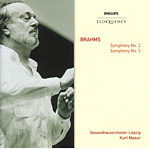A student perusing the scores of these symphonies would find this recording useful. Kurt Masur’s performances are solidly by-the-book, apparently striving to present the music as plain-faced as possible. Tempos are moderate-to-slow, which enables the would-be score reader to keep up, while orchestral textures are mostly transparent (that is, when the recording’s reverberant acoustic doesn’t overload in tutti passages), allowing the finer details of Brahms’ orchestration to emerge. Providing all this illumination is the Leipzig Gewandhaus Orchestra, an ensemble famous for its long-standing Brahms tradition. However, being a trademark “Brahms orchestra” doesn’t always guarantee the best performances. Masur is content to keep things moving in an unobtrusive, Kapellmeister-ish manner, meaning that, save for Symphony No. 2’s delightfully rendered third movement and the beautiful solo playing in No. 3’s Poco Allegretto, these performances lean toward the dull. Those seeking enjoyment rather than study are directed to the listed alternatives.
































